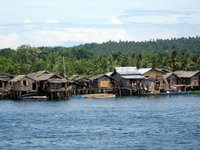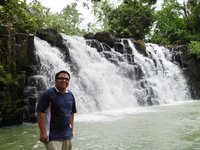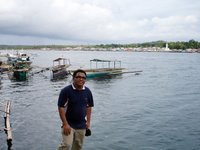 I was planning to get up early today but that didn't work. I was still unusually tired. Anyway, instead of the early morning fast craft to Isabela City in Basilan, I was able to catch the 9:30 a.m. The fare for a first class ticket was PHP130. The ordinary seats at PHP100, although also air-conditioned, are usually jampacked. So the extra PHP30 was worth it. I arrived in Basilan about an hour later.
I was planning to get up early today but that didn't work. I was still unusually tired. Anyway, instead of the early morning fast craft to Isabela City in Basilan, I was able to catch the 9:30 a.m. The fare for a first class ticket was PHP130. The ordinary seats at PHP100, although also air-conditioned, are usually jampacked. So the extra PHP30 was worth it. I arrived in Basilan about an hour later. Greeting you as you entered the port were villages on stilts and the minarets of mosques at the center of these communities. From the port, I took a short walk up to the provincial capitol where I decided to take a tricycle to the passenger terminal to Lamitan. My first stop for the day was a waterfalls in the heart of a town made infamous by the sensational clashes between the military and the Abu Sayaff a while back. And here I was on my way there for a visit!
Greeting you as you entered the port were villages on stilts and the minarets of mosques at the center of these communities. From the port, I took a short walk up to the provincial capitol where I decided to take a tricycle to the passenger terminal to Lamitan. My first stop for the day was a waterfalls in the heart of a town made infamous by the sensational clashes between the military and the Abu Sayaff a while back. And here I was on my way there for a visit!I took a commuter van to Lamitan which was about 27 kilometers away from Isabela. The trip costed PHP40. I was expecting to see bad roads after all that fighting years back but I was impressed since the roads to Lamitan were very well-paved, not a sign of the hostilities that ensued in the past.
 As soon as I arrived in Lamitan, I asked around on how to could get to Bulingan Falls. I was pointed to a motorcycle-for-hire who agreed to take me there for PHP100. It was fair enough since the falls were quite far. I would figure it was a 10-kilometer trip from the town proper to the falls, which was bumpy most of the way and quite muddy at times. The trip took me deeper into Lamitan town which I'm sure used to be evacuated often before when hostilities between the Abu Sayaff and the military were ongoing.
As soon as I arrived in Lamitan, I asked around on how to could get to Bulingan Falls. I was pointed to a motorcycle-for-hire who agreed to take me there for PHP100. It was fair enough since the falls were quite far. I would figure it was a 10-kilometer trip from the town proper to the falls, which was bumpy most of the way and quite muddy at times. The trip took me deeper into Lamitan town which I'm sure used to be evacuated often before when hostilities between the Abu Sayaff and the military were ongoing. You could still feel the turbulent past of the area since we passed by several military check points and camps along the way. One thing which surprised me was that the barangays going to the falls were predominantly Catholic since each had a little chapel. I didn't see a mosque either. It seems most of them could be found in the coastal areas.
You could still feel the turbulent past of the area since we passed by several military check points and camps along the way. One thing which surprised me was that the barangays going to the falls were predominantly Catholic since each had a little chapel. I didn't see a mosque either. It seems most of them could be found in the coastal areas.Bulingan Falls was not tall at all. But what made it nice were the square shaped rocks from which the water cascaded down to the pool below. You could see that the falls was frequented by tourists since the mayor had the banks cemented and built several picnic huts on the side. They could have done a better job though.
 It was then back down that dirt road to the town proper. Lamitan town has been turned into another of those nondescript Philippine communities. And the only distinguishing landmark in the center of town is the statue of its founder Datu Kalun.
It was then back down that dirt road to the town proper. Lamitan town has been turned into another of those nondescript Philippine communities. And the only distinguishing landmark in the center of town is the statue of its founder Datu Kalun.From Lamitan, I took a commuter van back to Isabela City. It was about 1 p.m. and after lunch, I decided to take a walk back to the pier. My plan was to take the last ferry back at 5:30 p.m. but since the weather was unpredictable, it would drizzle then the sun would come out, I decided to take the 3:30 p.m. trip back to Zamboanga.
Since I had time to spare, I asked about Malamawi Beach. It turns out, Malamawi is the island just across the port. And the beach on one side of the island was known to locals as White Beach obviously because of the white sand. There are frequent commuter pump boats which take passengers across the strait for PHP5. So since I had a lot of time, I decided to check it out.
The trip across was just about 5 minutes. At the opposite end, motorcycles-for-hire were waiting to take you to any point on the island. I was charged PHP20 one-way which was not bad. Again, it was off the beaten track since once you left Barangay Carbon proper, there were no roads, just motorcycle trails.
 It was quite a distance and the trip took you to the other side of the island, passing by small communities living in vast mangrove forests. Among the obstacles we had to avoid were the occasional cows grazing amongst the thick vegetation along the path.
It was quite a distance and the trip took you to the other side of the island, passing by small communities living in vast mangrove forests. Among the obstacles we had to avoid were the occasional cows grazing amongst the thick vegetation along the path. We finally arrived at the beach. And I wished I had brought my swimming gear! When visiting Malamawi White Beach, it's best that you go with a group and take a pump boat straight to the place. If you're alone, you'll have to make arrangements with the motorcycle to come back for you at a later time.
We finally arrived at the beach. And I wished I had brought my swimming gear! When visiting Malamawi White Beach, it's best that you go with a group and take a pump boat straight to the place. If you're alone, you'll have to make arrangements with the motorcycle to come back for you at a later time.There were a lot of run down beach huts and picnic tables all over the place; but just a small group of tourists enjoying the white sand. Sometimes you'd realize there are so many underrated beaches all over the country worth visiting, little pieces of paradise secretly tucked away for those diligent enough to search for them and enjoy the serenity they offer.
 After a few photos, it was back to Barangay Carbon, and then back to the port of Isabela just across. Again, I purchased a first class ticket which was a passport to comfort since I did not have to join the rat race into the fast craft since only a few people buy the said tickets.
After a few photos, it was back to Barangay Carbon, and then back to the port of Isabela just across. Again, I purchased a first class ticket which was a passport to comfort since I did not have to join the rat race into the fast craft since only a few people buy the said tickets.By the time we neared Zamboanga, I was already very dizzy. It was an ordeal walking back to the pension house. But I decided to take a quick snack at Tini's where I bought my favorite roti telor and roti kosong (flour pancakes accompanied with curry dip). When I got back to the pension house, the next thing I knew was I was asleep again. I made sure I got enough rest since I had to be up early to catch the boat to Santa Cruz Island the next day.






